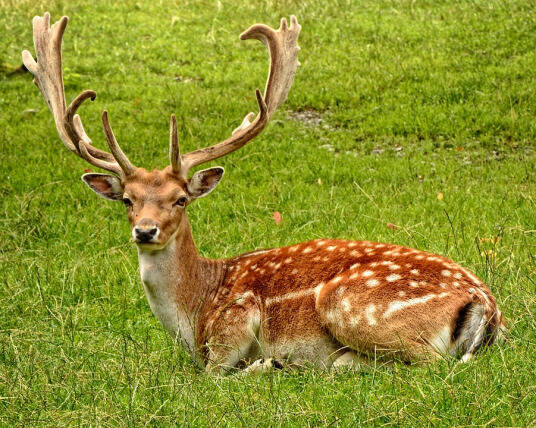Dama dama
IUCN
LCBasic Information
Scientific classification
- name:Dama dama
- Scientific Name:Dama dama,Fallow Deer
- Outline:Ungulata
- Family:Artiodactyls Cervidae Fallen Deer
Vital signs
- length:130-160cm
- Weight:40-70kg
- lifetime:About 12 years
Feature
One of the most beautiful deer in Europe
Distribution and Habitat
During the last Ice Age, the fallow deer was once widespread in the southern Mediterranean and North Africa, but was later found to be extinct throughout the British Isles and Europe. The fallow deer was brought back to northern and western Europe by the Romans in 1169 and re-entered Britain.
Origin: Turkey.
Introduced: Argentina, Austria, Belarus, Belgium, Canada, Chile, Czech Republic, Denmark, Estonia, Fiji, Finland, France, Germany, Hungary, Ireland, Latvia, Lithuania, Luxembourg, Moldova, Netherlands, New Zealand, Norway, Peru, Poland, Portugal, Romania, Russian Federation, Slovakia, South Africa, Spain, Sweden, Switzerland, Ukraine, United Kingdom, United States, Uruguay
Uncertain distribution: Albania, Bosnia and Herzegovina, Bulgaria, Croatia, Cyprus, Greece, Italy, Sardinia, Macedonia, Montenegro (Serbia), Slovenia.
The fallow deer generally inhabits mixed woodlands and open grasslands, living in the woods of the Mediterranean in southern Europe, and is a forest an
Appearance
The fallow deer is a medium-sized deer species, slightly larger than a goat. The male is 140-160 cm long, 90-100 cm tall at the shoulder, and weighs 55-70 kg. The female fallow deer is slightly smaller, 130-150 cm long, 75-85 cm tall at the shoulder, and weighs 40-45 kg. The antlers on the head are generally 60 cm long. Fawns are generally born in spring, with a body length of 30 cm and a weight of 4.5 kg at birth. The fur of the fallow deer is brownish yellow with white spots in the summer, and turns into gray-black stripes in winter. The lower abdomen is white, and the stripes on the buttocks form a distinct outline of white and black. The black stripes extend to the lower back and the surface of the tail. The life span of the fallow deer is about 12 years. Only male fallow deer have antlers.
The fallow deer is one of the most beautiful deer in Europe. Mature fallow deer and young fallow deer have white spots on their dark chestnut fur. Fallen deer come in black, white and brown v
Details
Fallow Deer (scientific name: Dama dama) has two subspecies.

Male fallow deer in estrus will expand their territory, and female fallow deer will join them. The population can reach up to 150 at most. They like to live in groups and are particularly good at running. Fallen deer herds have no concept of territory, but go foraging in family units. The living area also overlaps with other deer herds. The size of the herd varies according to the season. Most fallow deer live in two different groups, adult females with one-year-old fawns, and young male deer from three to five years old gather in small groups by themselves, and male deer live alone. The female group is led by the female deer. During the mating season, the two groups will gather together. Fallen deer are mainly herbivores, feeding on grass, twigs, leaves, acorns and sugar beet crops.
The estrus and mating season of fallow deer is in October. Male deer join the female herd, and the female deer are pregnant in May and June, with one calf per litter. Fawns are born after 33 weeks. Fawns weigh about 4.5 kilograms at birth. During this period the fawn follows its mother around, hiding near the bushes. Fawns reach sexual maturity at 18 months, at which time the young males leave the female herd. After another 5 or 6 years, when they reach physical maturity, they can challenge other mature males.
The nominate fallow deer is not an endangered species. It is protected as a game species. For hunting purposes, they have been living in parks and hunting grounds from Roman times to modern times. The Persian fallow deer (Mesopotamian fallow deer) is considered to be endangered. The natural enemies of wild fallow deer are carnivorous wolves, lynxes and bears. Fawns are occasionally preyed on by foxes.
Listed in the IUCN Red List of Threatened Species in 2008 ver 3.1 - Least Concern (LC).
Protect wild animals and stop eating game.
Maintaining ecological balance is everyone's responsibility!








